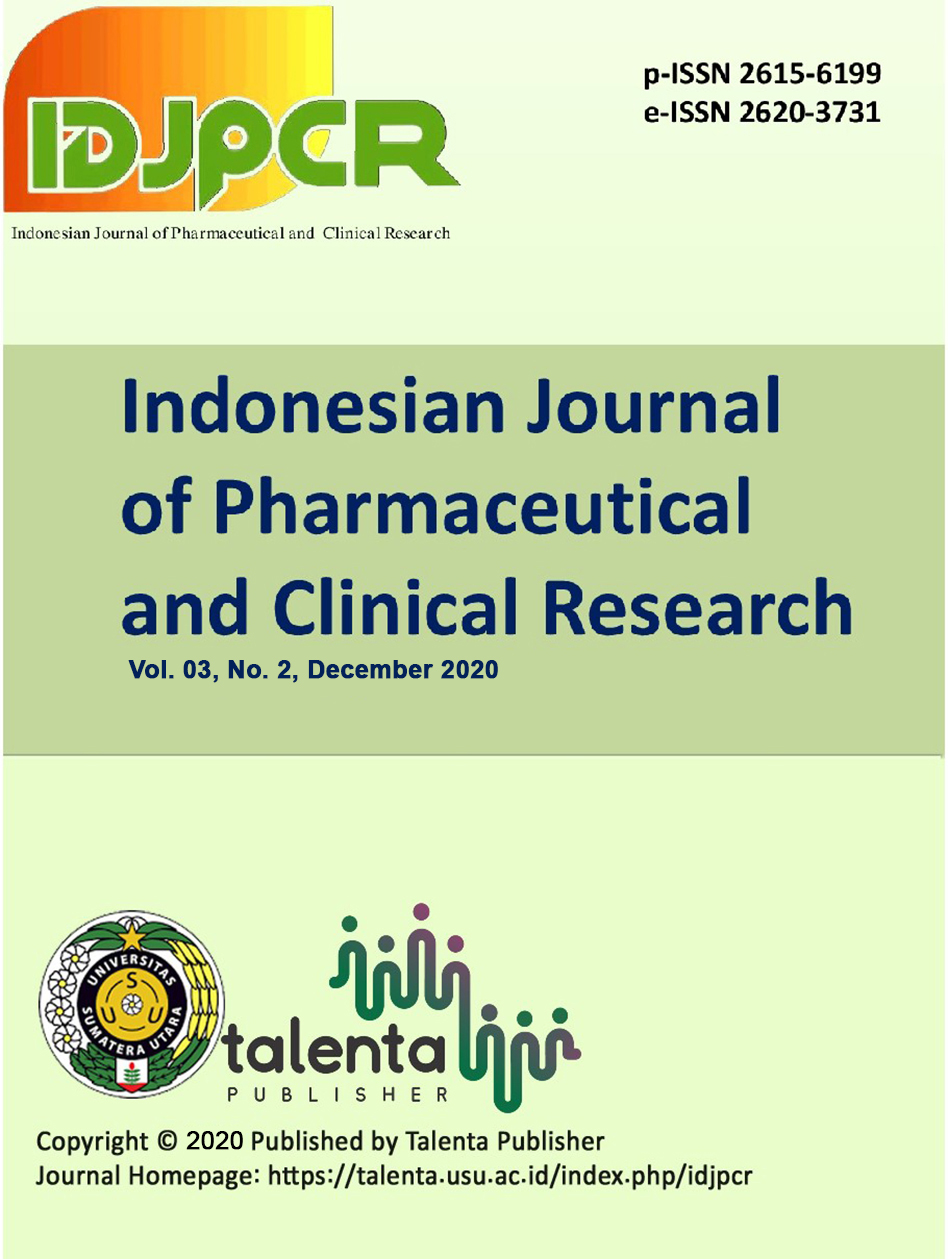Evaluation of Supplement Consumption on North Sumatera Regional Police Headquarters Personnel
DOI:
https://doi.org/10.32734/idjpcr.v3i2.4333Keywords:
Evaluation, Consumption Pattern, Supplements, Potential InteractionsAbstract
The purpose of his study was to determine the factors that influence the consumption pattern of supplements, and to prove the potential interactions of anti-cholesterol, antihypertensive, anti-uric acid, and antidiabetic drugs with supplements. This research is a descriptive research with a survey method. Data collection was carried out on 373 North Sumatera Regional Police Headquarters Personnel. This study used the dependent variable, namely the pattern of supplement consumption, while the independent variables were age, gender, health status, perception, information sources and physical activity. The results of the study using descriptive statistical tests presented using tables and percentages. The results showed that the factors that influenced the pattern of supplement consumption were male (57.1%); 30-49 years old (62.5%); healthy condition (63%); perception as a stamina enhancer (61.7%); sources of information (62.2%) and strenuous physical activity (49.9%). There are synergistic interactions of anti-cholesterol drugs with supplements and antagonistic interactions of antihypertensive, anti-diabetic, anti-gout drugs with supplements.
Downloads
References
B. Carratù and S. Giammarioli, “Food Supplements Containing Botanicals: The Concept of Quality,†Food Supplements Containing Botanicals: Benefits, Side Effects and Regulatory Aspects, pp. 179–195, 2017.
V. Dobrovolskij, “Prevalence of food supplement use and opinion about food supplements among Lithuanian residents,†European Journal of Public Health, vol. 28, no. supplement 4, 2018.
Anonym, “Food supplements,†Food Law: Policy & Ethics, pp. 272–274, Jun. 2001.
A. Perelson and L. Ellenbogen, “Rationale for Use of Vitamin and Mineral Supplements,†Handbook of Nutrition and Food, 2001.
Arcy PF. “Adverse Drug Reaction Update,†Adverse Drug Reactions and Toxicological Reviews, vol. 21, no. 1–2, pp. 113–120, 2002.
C. Rona and E. Berardesca, “Aging skin and food supplements: the myth and the truth,†Clinics in Dermatology, vol. 26, no. 6, pp. 641–647, 2008.
A. Sato, A. Kamei, E. Kamihigashi, M. Dohi, Y. Komatsu, T. Akama, and T. Kawahara, “Use of Supplements by Young Elite Japanese Athletes Participating in the 2010 Youth Olympic Games in Singapore,†Clinical Journal of Sport Medicine, vol. 22, no. 5, pp. 418–423, 2012.
“Low carbohydrate information, consumer health preferences and market demand of fruits in the United States,†The Applied Economics of Weight and Obesity, pp. 110–114, 2016.
RI. Permenkes, “Angka Kecukupan Gizi yang Dianjurkan Bagi Bangsa Indonesiaâ€. 2013
L. Bergstrom, “The Use of Multiple Dietary Supplements,†Journal of Dietary Supplements, vol. 6, no. 1, pp. 1–8, 2009.
B. J. Lyle, J. A. Mares-Perlman, B. E. K. Klein, R. Klein, and J. L. Greger, “Supplement Users Differ from Nonusers in Demographic, Lifestyle, Dietary and Health Characteristics,†The Journal of Nutrition, vol. 128, no. 12, pp. 2355–2362, 1998.
J. L. Greger, “Dietary Supplement Use: Consumer Characteristics and Interests,†The Journal of Nutrition, vol. 131, no. 4, p. 1339S–1343S, 2001.
H.G. Yasin, M.J. Mejaya, F. Kasim and Subandi, “Development of Quality Protein Maize (QPM) In Indonesiaâ€. Proceedings of The Ninth Asian Regional Maize Workshop. Beijing. China, p. 282, 2005.
C. S. Thummel, “Molecular Mechanisms of Developmental Timing in C. elegans and Drosophila,†Developmental Cell, vol. 1, no. 4, pp. 453–465, 2001.
J. Schwartz, “Effects of Vitamin D Supplementation in Atorvastatin-Treated Patients: A New Drug Interaction With an Unexpected Consequence,†Clinical Pharmacology & Therapeutics, vol. 85, no. 2, pp. 198–203, 2008.
T. Neunteufl, R. Katzenschlager, A. Hassan, U. Klaar, S. Schwarzacher, D. Glogar, P. Bauer, and F. Weidinger, “Systemic endothelial dysfunction is related to the extent and severity of coronary artery disease,†Atherosclerosis, vol. 129, no. 1, pp. 111–118, 1997.
A. Antony, “Amlodipine Abridged Calcium Associated Complex-I Inhibition in 6-OHDA Lesioned Parkinson’s Rat,†British Journal of Pharmaceutical Research, vol. 4, no. 10, pp. 1269–1275, 2014.
M. A. Ahmed, G. Muntingh, and P. Rheeder, “Vitamin B12 deficiency in metformin-treated type-2 diabetes patients, prevalence and association with peripheral neuropathy,†BMC Pharmacology and Toxicology, vol. 17, no. 1, 2016.
S. H. Ganji, V. S. Kamanna, and M. L. Kashyap, “Niacin and cholesterol: role in cardiovascular disease (review),†The Journal of Nutritional Biochemistry, vol. 14, no. 6, pp. 298–305, 2003.
S. Tavintharan and M. L. Kashyap, “The benefits of niacin in atherosclerosis,†Current Atherosclerosis Reports, vol. 3, no. 1, pp. 74–82, 2001.
G. L. Vega, N. B. Cater, S. Meguro, and S. M. Grundy, “Influence of Extended-Release Nicotinic Acid on Nonesterified Fatty Acid Flux in the Metabolic Syndrome With Atherogenic Dyslipidemia,†The American Journal of Cardiology, vol. 95, no. 11, pp. 1309–1313, 2005.
C. Ben Salem, R. Slim, N. Fathallah, and H. Hmouda, “Drug-induced hyperuricaemia and gout,†Rheumatology, p. kew293,2016
Downloads
Published
How to Cite
Issue
Section
License
Copyright (c) 2020 Indonesian Journal of Pharmaceutical and Clinical Research

This work is licensed under a Creative Commons Attribution-ShareAlike 4.0 International License.
The Authors submitting a manuscript do so on the understanding that if accepted for publication, copyright of the article shall be assigned to Indonesian Journal of Pharmaceutical and Clinical Research (IDJPCR) and Faculty of Pharmacy as well as TALENTA Publisher Universitas Sumatera Utara as publisher of the journal.
Copyright encompasses exclusive rights to reproduce and deliver the article in all form and media. The reproduction of any part of this journal, its storage in databases and its transmission by any form or media, will be allowed only with a written permission from Indonesian Journal of Pharmaceutical and Clinical Research (IDJPCR).
The Copyright Transfer Form can be downloaded here.
The copyright form should be signed originally and sent to the Editorial Office in the form of original mail or scanned document.









